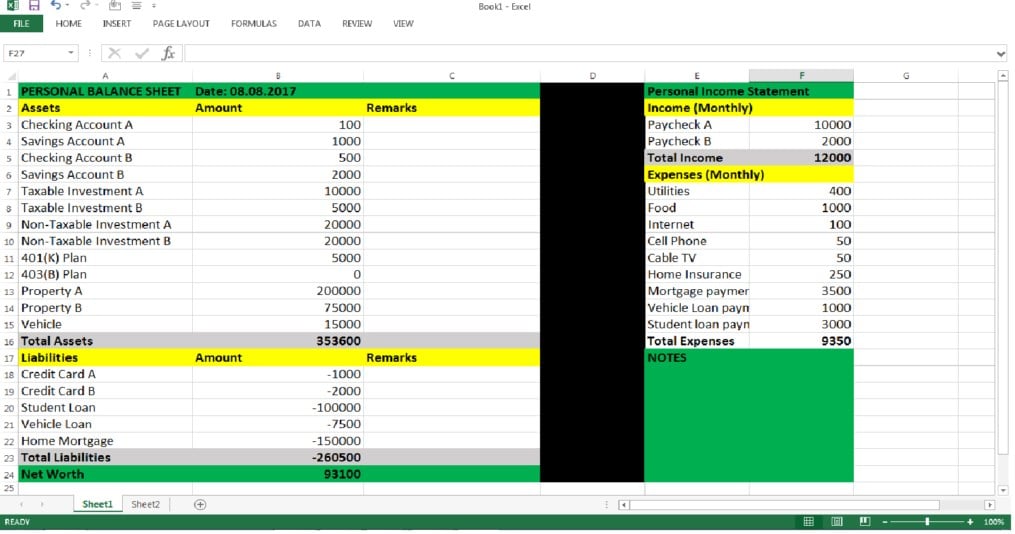A personal financial statement is a form or document or spreadsheet detailing a person’s financial state at a given point in time. This statement is typically used to demonstrate a party’s creditworthiness or financial stability. A personal financial statement will typically include general information about the individual, such as name and address, along with a breakdown of total assets and liabilities.
The personal financial statement form will include all information about the party. This includes their full name, address, and identification number. A complete list of total assets and total liabilities is included to provide the recipient with a clear look at the party’s financial state. Current debts, along with income, is used to determine creditworthiness. The statement is useful for tracking goals and wealth. It is also often required when applying for credit.
When Do I Need a Personal Financial Statement?
If you are presenting a business plan or business loan request to a lender, they will probably ask for a personal financial statement. In many cases, you may be asked to provide a personal guarantee for part of the loan, or you may have to pledge some of your personal assets to guarantee the loan. Sometimes this is called a collateral loan.
The personal financial statement will be required so the lender can see if you have enough assets and what kinds of assets you have. An individual’s financial statement shows their net worth, which is assets minus liabilities. Net worth reflects what an individual will have in cash if they sold off all their assets and paid off all their debts.
If liabilities are greater than assets on the personal financial statement, then the individual has a negative net worth. If the individual has more assets than liabilities, they have a positive net worth.
- The personal financial statement lists all assets and liabilities of an individual or couple.
- Subtract liabilities from assets to see the net worth. Positive net worth shows that the person has more assets than liabilities.
- Net worth can fluctuate over time as asset and liability values change.
- Personal financial statements are helpful for tracking wealth and goals, as well as applying for credit.
- Income and expenses can be included, but ideally, these are placed on a separate sheet called the income statement.
Personal Financial Statement Template
The format of the personal financial statement is standard. It shows assets on the left and liabilities on the right. Net worth is also shown on the right, to balance the equation.
Personal Financial Statement Form
A personal financial statement should contain the following basic elements:
- Personal information – This means your full legal name, address, telephone number, and any other contact information you’d like to share. This information is used to identify who the personal financial statement is for. If you’re an entrepreneur trying to get a loan or investment, you may also want to include the name of your business.
- A balance sheet, or “statement of financial position” – This lists your assets and liabilities and calculates your “net worth” by subtracting the number of your liabilities from the number of your assets. For example, if you have $100,000 in assets and $65,000 worth of liabilities, your net worth would be $35,000. You’ll need to do a bit of research in order to accurately complete this portion of your personal financial statement because the valuable property must be appraised. You must also pull your credit report and check the status of all your unpaid debts. Be sure that you check your math several times to ensure the accuracy of your numbers. The purpose of a personal financial statement is that it accurately portrays your financial situation. If you provide a potential investor or creditor with inaccurate numbers, they are unlikely to help you.
How To Prepare A Personal Financial Template?
To begin, start gathering information about assets and liabilities. The personal financial statement shows assets and liabilities and net worth at a specific point in time, so just prepare the document with the most recent information you have. Your lender understands that some of this information is changing as you go about making your personal Financial Transactions (making payments, for example). And investment values change over time too.
If you are unsure of the value of assets, do your best to get a reasonable figure. If the lender wants to use the asset for a guarantee on your business loan, they will do an appraisal.
Read Also: Investment Banking Analyst
As part of your preparation for presenting your business plan, you should run a complete credit report on yourself, because the lender will certainly do this. This means getting not just the FICO score, but a report that shows details.
Personal Financial Statement Example
A combined view of the Sample Personal Financial Statement

